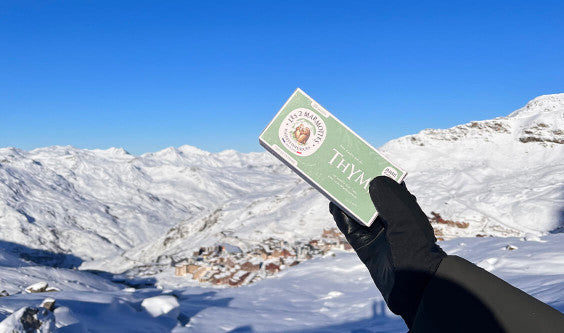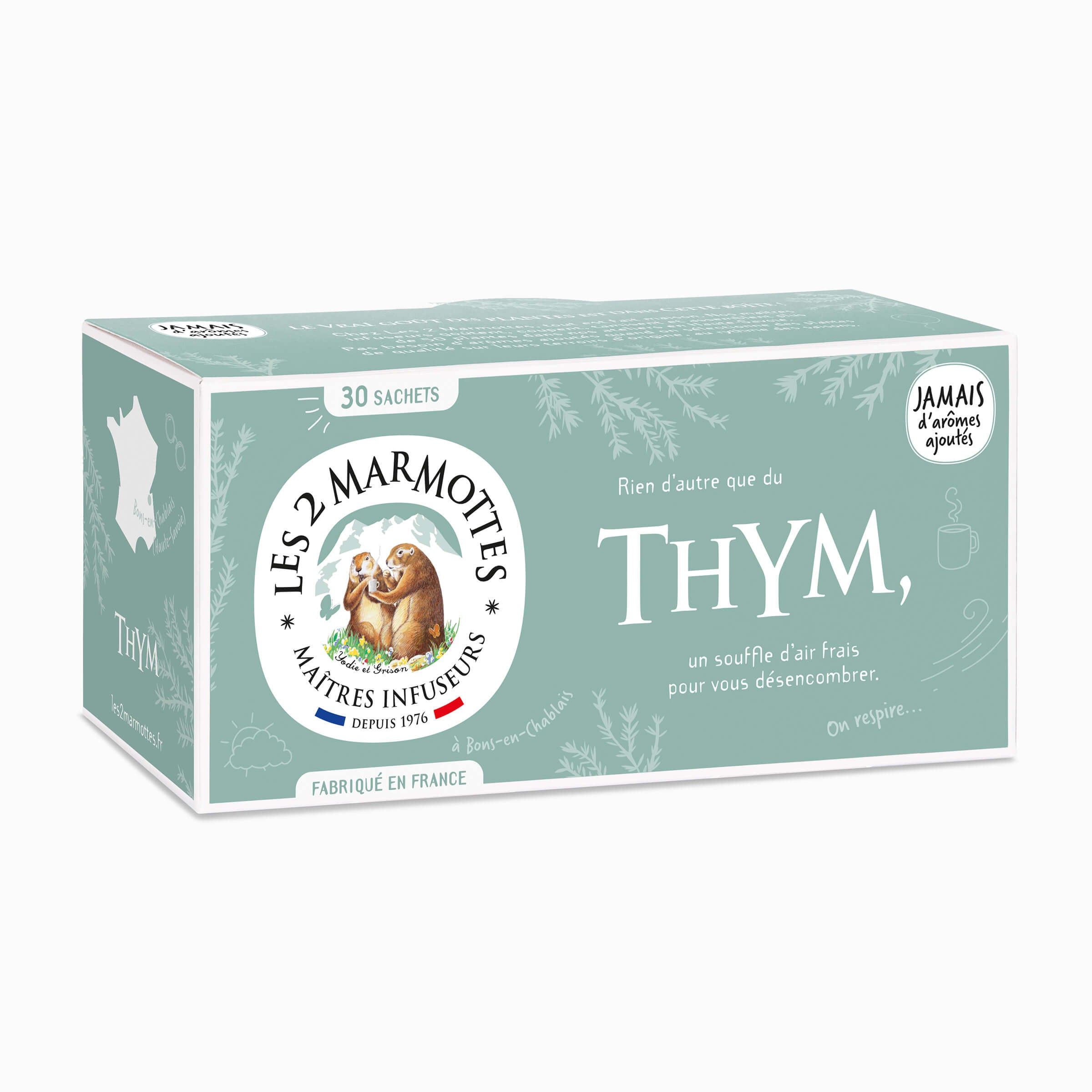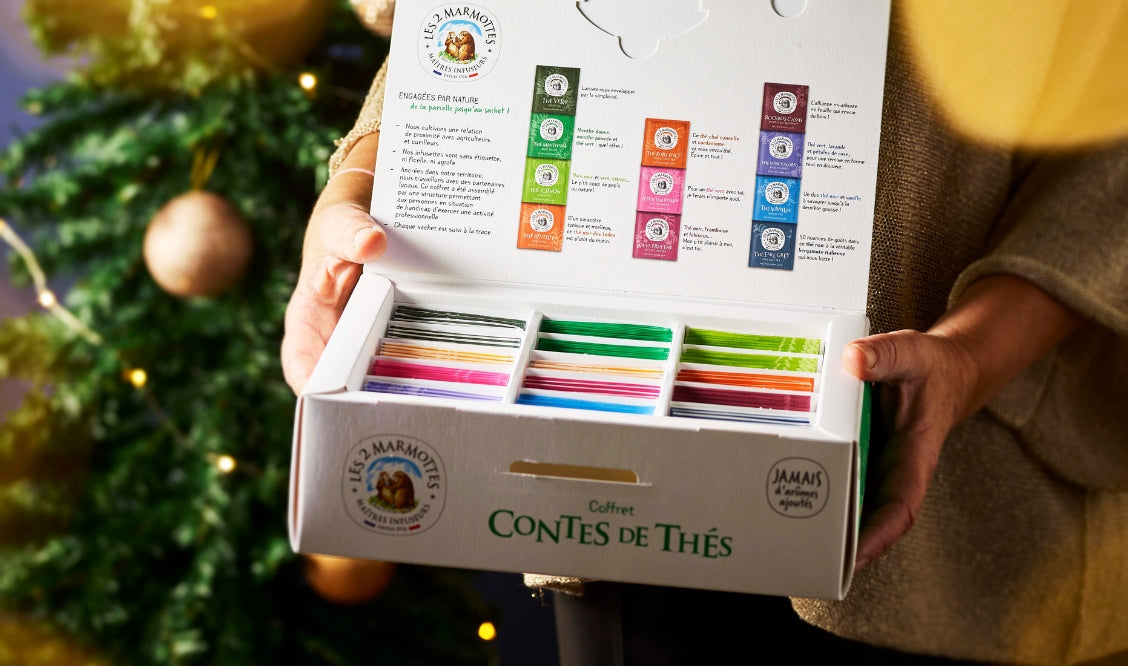Number one among plants that wish us well, thyme has more than one good "plant" on the shelves. Season after season, this small Mediterranean plant is with us.
Autumn: prepare your body with the benefits of thyme
Marmots are often asked when they can drink thyme tea .
Although you can drink herbal teas all year round, fall is the perfect time to take some time for yourself and prepare for the fight against winter's minor ailments . Thyme contains natural antioxidants that allow it to play on many levels.
Used to support natural immunity and aid digestion (it helps combat bloating in particular), thyme will help you take life on the bright side and stay in shape throughout the season.
Easy to consume as a herbal tea, thyme is one of the plants often recommended for prevention to support the immune system and help us fight off possible infections.
Winter: Fight minor winter ailments with thyme
Thanks to its natural essential oils containing active ingredients like thymol, thyme is always a good choice when it comes to supporting our respiratory health. Its soothing and pleasant effect on the throat, pharynx, and vocal cords is an ally when it comes to fighting bronchial infections.
But thyme doesn't stop there: it also has antitussive and expectorant properties. Suffice it to say that at the first coughing fit, the first tickle in the throat, or in case of a runny nose, it's best to whip out a thyme infusion to prevent things from getting out of hand!
The lemon-thyme herbal tea you won't be able to live without
Ingredients for a homemade lemon thyme infusion :
- 2 liters of water
- ½ lemon
- 1 tablespoon of thyme honey
- 1 piece of ginger about 2 cm
- 1 bunch of thyme or 1 thyme infusion bag
Pour the cold water into a saucepan, add the bunch of fresh thyme (or the 100% herbal thyme infusion bag ) and heat. As soon as the water boils, remove the pan from the heat, let it infuse for about fifteen minutes and filter.
In a mug or bowl, add the juice of half a lemon and the finely diced ginger. Pour your thyme-scented water into the mug and stir. Once the water has cooled slightly, add the honey. It's ready!
Spring: the boost of thyme
As winter comes to an end, no one is against a boost.
For this, you can count on the invigorating side of thyme. Combined, for example, with eucalyptus and lemon (as in the Après-Ski infusion from Les 2 Marmottes), it becomes a drink full of freshness and pep... Ideal for setting the clocks back and switching to summer time. And when the pollens start to show up again and the hay fever season has begun, we remind you that thyme has a beneficial effect on the proper functioning of the upper respiratory tract...
Summer: put some sunshine in your cup with thyme
Too often confined to winter, thyme nevertheless promises beautiful sunny escapes, especially if it is well accompanied!
Tasty alongside summer fruits like raspberry or apricot, it also brightens up summer infusions with thyme or oregano.
We've already shared a recipe for strawberries with thyme as a summer dessert. Discover it in a refreshing drink version, such as an iced thyme and raspberry herbal tea :
Iced thyme-raspberry herbal tea to refresh your mind
Ingredients for iced thyme-raspberry herbal tea :
- 1 liter of water
- 5 grams of thyme (about 1 teaspoon) or 2 pure thyme infusion bags
- 150 grams of raspberries (about 3 tablespoons)
- 1 lemon
- 3 tablespoons of thyme honey
Heat ¼ liter of water to 90° and let the tea infuse for about ten minutes.
Strain to remove any thyme pieces or tea bags, then add the remaining 75 centilitres of water, the lemon juice, crushed raspberries, and honey. Stir and refrigerate for an hour. Voila, your summer infusion is fresh!
Feel free to add a few ice cubes when serving.
Real news or thyme? Let's take a look at thyme!
Thyme has been used as a medicinal plant since time immemorial.
As evidenced by ancient pottery and some very old papyri, the Egyptians used thyme in their medicinal concoctions. Thyme was also used for embalming bodies.
As for the Greeks, they had the habit of burning sprigs of thyme in their temples.
Thyme arrived in the kitchen late
That's false! In Apicius, one of the earliest known culinary works (it dates back to Antiquity), thyme is already mentioned as an aromatic herb.
It's logical, it's an aromatic herb typical of the Mediterranean, with a very distinctive fragrance. The ancient peoples of the Mediterranean basin had no trouble identifying and using it. The Romans in particular used it to flavor liqueurs and cheeses.
Thyme is one of the aromatic plants that is easy to grow at home.
It's true! Thyme is really not fussy and adapts to almost all climates in mainland France.
Depending on the region, you will choose the most suitable species of thyme .
This perennial, frost-resistant plant can thrive in a pot (preferably in partial shade) or in the garden, in full sun. You can also plant it in a greenhouse.
Good to know for beginner gardeners:
- Thyme needs at least 6 hours of sunlight per day. Before planting, check the exposure of the area you have in mind. Does it receive sun at different times of the day (morning, evening, etc.)? Are there any elements that can cast shade depending on the season (e.g., a tree with all its leaves in summer will cast more shade than the same tree bare in winter).
-Thyme likes well-drained soil. Yes, it is native to the garrigue! It will not like heavy, clay-type soils. If you plant it in a pot, you can add a little gravel to the bottom of the pot.
- thyme is not too afraid of the cold: it can withstand temperatures down to -15°C, a temperature at which marmots huddle deep in their burrows! Its foliage is evergreen and will last all winter.
- Thyme does not like humidity at all. Avoid planting it too close to a pond or a lake.
Be careful, if you consume thyme grown in the garden (in cooking or to make herbal teas yourself), wash it well before using it. As with wild-harvested plants, you are never safe from the passage of an animal (fox, cat, dog, etc.) which can bring bacteria to the plants.
Wash your hands, shake the thyme sprigs to remove dust and foreign matter, rinse them under water and dry them thoroughly.
There are over 300 species of thyme
There are even 350 of them, according to the master brewers!
The genus "Thymus" is part of the large Lamiaceae family, which includes rosemary and mint.
Among the most well-known species of thyme are:
- Common Thyme, a garrigue thyme easily found in the south of France
- Alpine thyme, which as the name suggests is suitable for mountain climates
- Lemon Thyme, with a strong aroma that evokes citrus notes
- Red thyme, very powerful, which is one of the 3 species that make up marmot thyme tea.
Corsican thyme smells of cumin
That's right. In fact, each thyme offers a different palette of flavors. This can range from cumin to orange, lemon, or even lavender. Moreover, marmot thyme tea is composed of several thyme essences , to obtain a specific aromatic power.
Corsican thyme (Thymus herba-barona) is found only in Corsica and certain regions of Sardinia. Its distinctive aroma stands up well to prolonged cooking.
The use of thyme is recognized by the WHO
The World Health Organization (WHO) recognizes the use of thyme "against dyspepsia (difficult digestion) and other gastrointestinal disorders, against coughs during colds or bronchitis, and as a gargle against laryngitis and inflammation of the tonsils."
Other health authorities are doing the same.
The French National Agency for the Safety of Medicines and Health Products (ANSM) includes thyme on its list of traditionally used medicinal plants.
The European Medicines Agency (EMA) considers thyme "traditionally used as an expectorant, cough suppressant and cold remedy."
You can be allergic to thyme
It happens! Thyme belongs to the Labiatae family (also called Lamiaceae or Labiatae), like mint, sage, basil, oregano, hyssop, and rosemary.
An allergy to this family can sometimes exist, even if cases are very rare.
Do not hesitate to consult a health professional before starting any thyme treatment .
Thyme helps fight menstrual pain
Not demonstrated to date.
Thyme is sometimes recommended in herbal medicine for painful periods, with the idea of using its anti-inflammatory properties.
Fennel and chamomile are other herbs recommended for menstrual pain .
Wild thyme and wild thyme are the same thing.
Almost, wild thyme is the name given to wild thyme.
It is a species of thyme different from Common Thyme. Its nickname is Thymus serpyllum.
Its particularity differentiates it from common thyme: it covers the ground in a thick carpet.
Thyme is more effective as a cure
When seeking to benefit from the benefits of thyme , it is important to respect the dosage.
To obtain a decongestant effect, it is recommended to consume 2 cups of thyme infusion per day as a course of treatment for one week.
Do not hesitate to consult a health professional before undertaking any herbal treatment.







